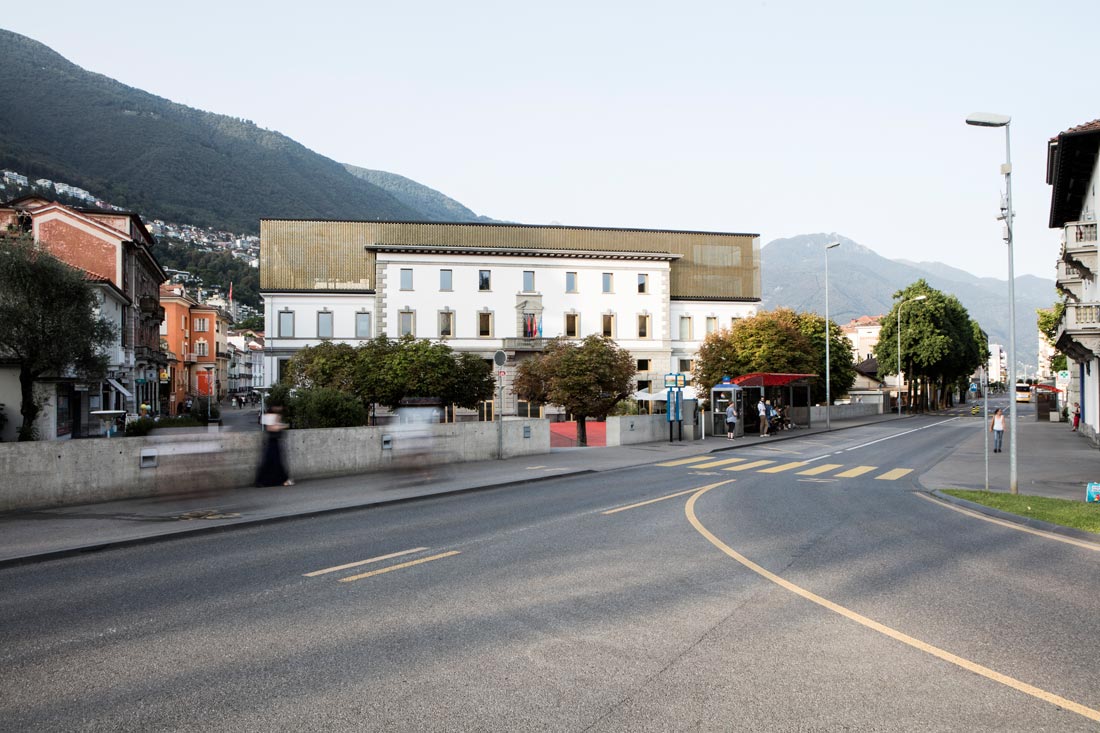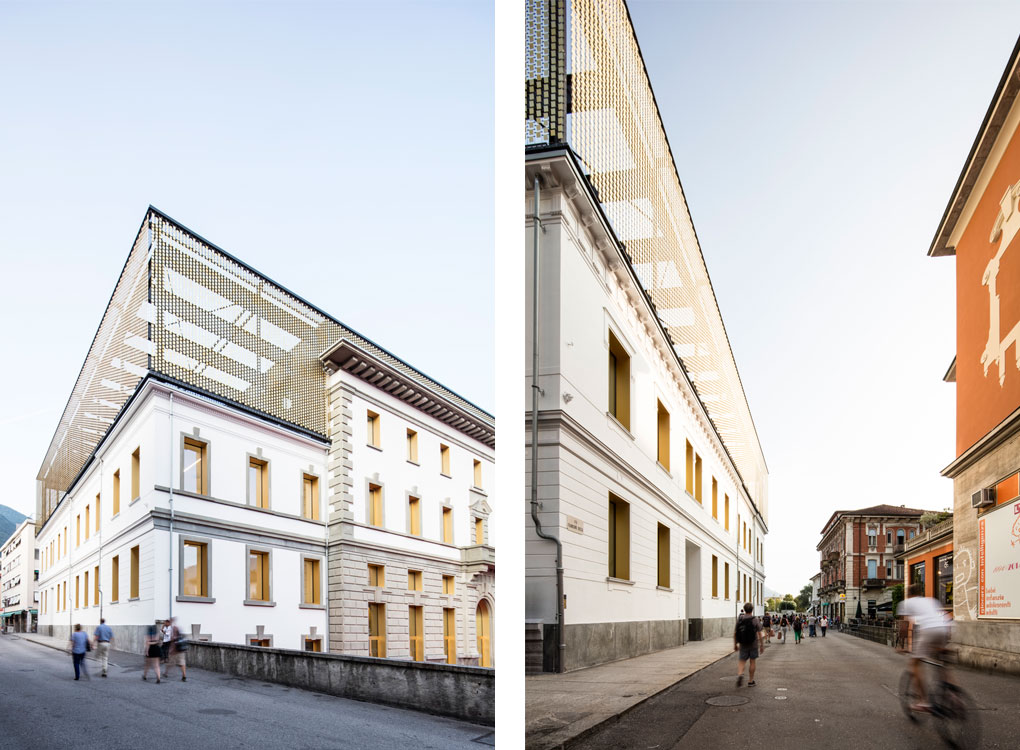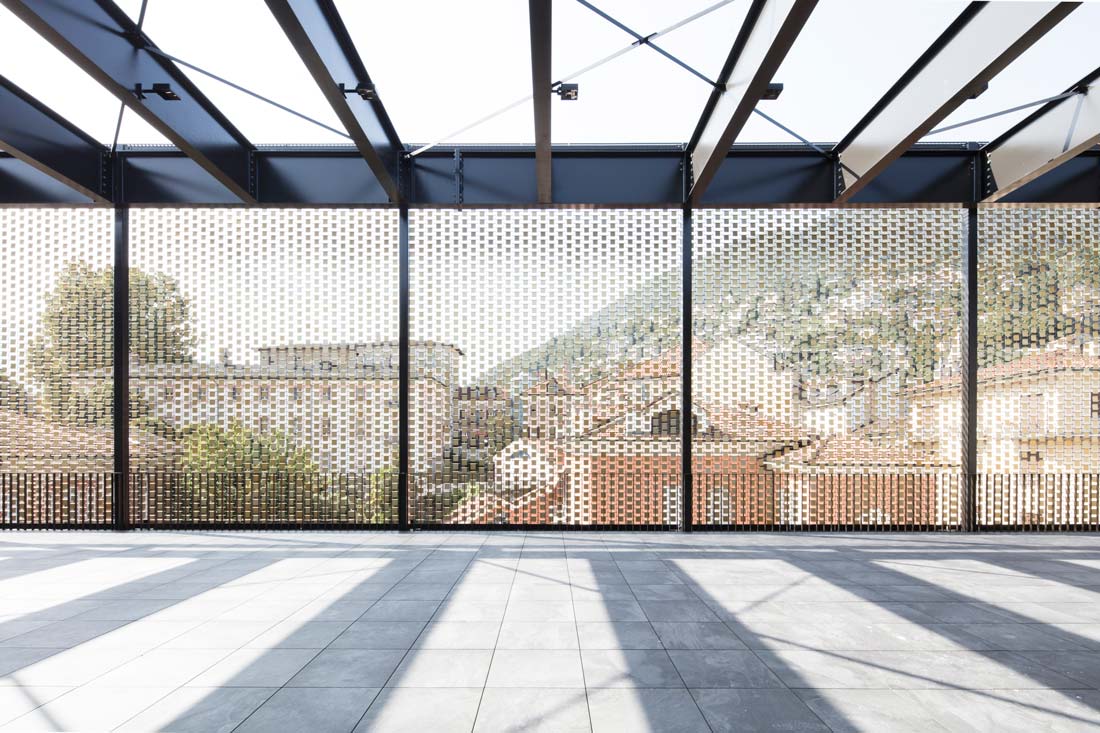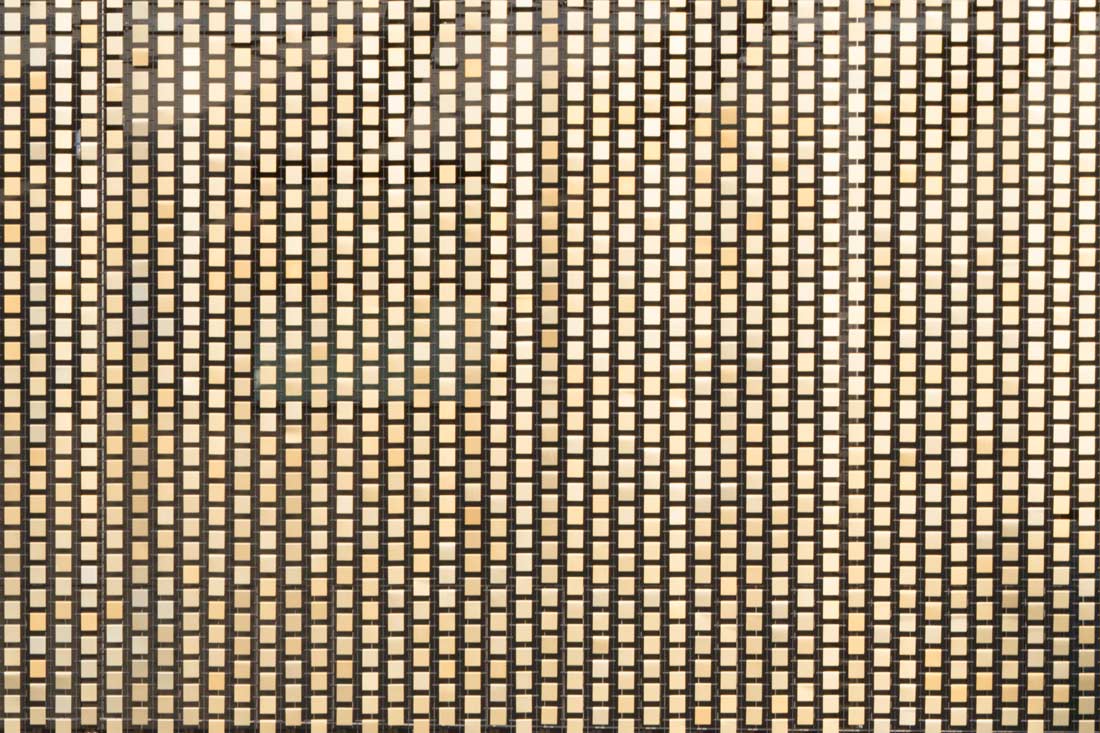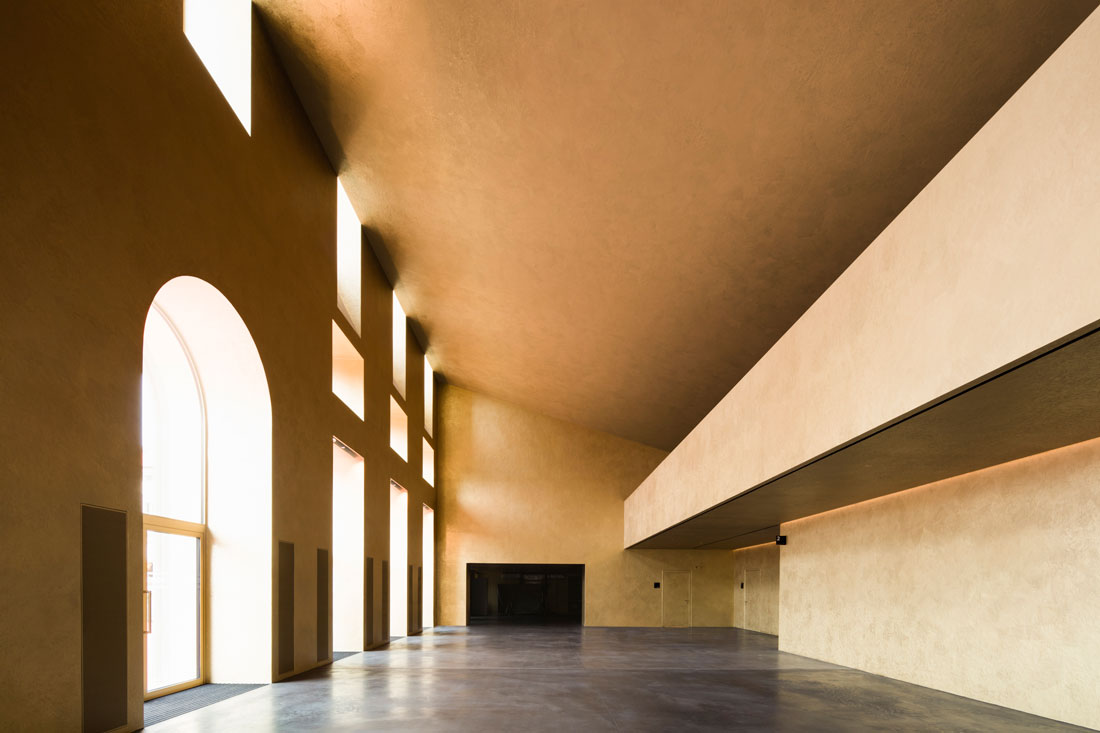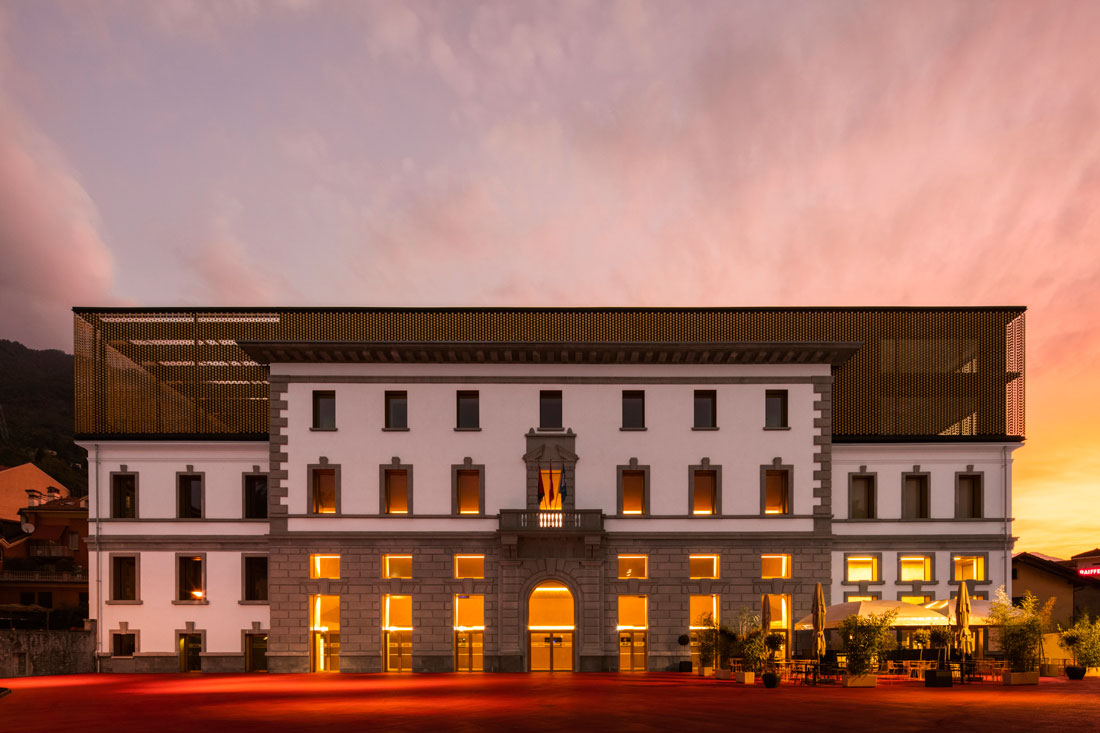Alejandro Zaera-Polo and Maider Llaguno-Munitxa (AZPML) have reinterpreted a classical masterpiece within the renovation of the historical building of the Palazzo Scolastico, converting it to a new cinema complex and bringing it back to the present through simple gestures.
Our proposal for the future Palazzo del Cinema di Locarno aims to build a physical structure that will constitute the urban identity of the Locarno Film Festival. The project aims to bring together the infrastructural needs of the Locarno Film Festival, the pre-existent physical structure of the Palazzo Scolastico and the Piazza Remo Rossi to synthesise a structure which will capture the presence of the Film Festival within the city of Locarno. The Locarno Film Festival does not have yet a recognisable home within the city, and the complex of the Palazzo Scolastico and the Piazza Remo Rossi represents a great opportunity to embed the Film Festival within an urban structure which already has deep affective relations to the Locarno citizens and a significant presence in today’s cityscape. We hope that our project will be able to intensify both the presence of the Film Festival and the City of Locarno.
When conceiving our proposal for the Palazzo del Cinema di Locarno, we have tried to avoid the dominant trend during the last few decades: that public architecture needs to make extravagant gestures in order to curate our cities’ public realm. In the aftermath of the 2007 global financial crisis and rampant global warming – and perhaps the demise of “starchitecture” as a default procedure to build urban identity – our proposal is guided by principles of economy. It tries to capitalise on the existing structure and the public affection for the Palazzo Scolastico, which used to host the local schools and now hosts a variety of NGOs and community associations, to provide an architectural identity for the new cinema complex in Piazza Remo Rossi.
There are two primary aims in our project:
Economy of resources through urban recycling. At a time when energy resources are dwindling and climate change has become a crucial problem for our cities, it would have been irresponsible to simply discard the existing building in order to build an entirely new one, with the corresponding expenditure of vital resources. Urban Recycling is a more adequate strategy for this intervention. Revitalising the Piazza Remo Rossi as an urban public space associated with the new function of the building as a new Film Centre for Locarno is also an important part of both the urban strategy and the branding strategy for the Film Festival, which has a tradition of occupying open urban space. We believe that this is also a more economic strategy than the construction of an entirely new building: the savings in building an entirely new structure for the building will easily offset the expenditure needed to reinforce the foundations of the Palazzo Scolastico, which the city is committed to preserve.
Consolidation and rebranding of the public identity of the Palazzo del Cinema di Locarno. It is our intention to capitalise on both the visibility and the public appreciation for the complex formed by the Palazzo Scolastico and the Piazza Remo Rossi in order to provide a strong urban identity to the new facility for the Film Festival and the Film Centre, and to weave those two institutions effectively into the urban fabric of Locarno. The building needs to assume the representation of its new function as a centre for international film culture with a distinctive presence, while being able to consolidate the pre-existent urban fabric. The articulation between the old building’s fabric and the Film Festival, the CCCA and the AF will produce the new physical presence of the complex. We believe that a superficial treatment of the existing shell will enable an effective rebranding of the structure.
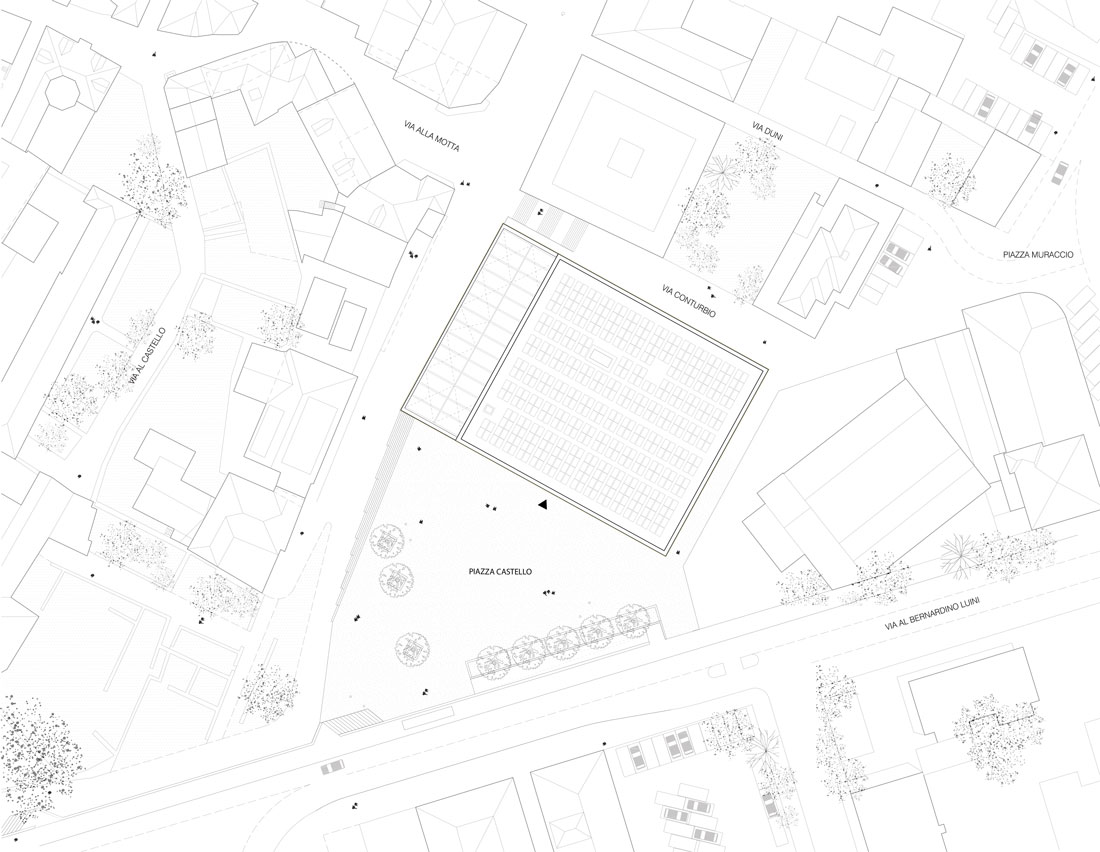 Site Plan
Site Plan Axonometry
Axonometry
Urban recycling and historical preservation
The requirement of having to place the building on the same grounds as the old Palazzo Scolastico, the masterpiece by the architect F. Bernasconi, has been a determinant in the conception of the project. The preservation of historical remnants in the urban fabric is a way of maximising an emotional engagement between the citizens and the town. Beyond the preservation of the historical memory of Locarno, we believe that the Palazzo Scolastico is an adequate building that deserves to be preserved and recycled. The presence of its enclave, facing the main point of access into Locarno, provides a strategic value to the building that should be considered when planning the urban location of the Film Festival. Considerations of an economic nature have also led us to propose an intervention that maintains the envelope of the existing building in its entirety, as well as some of its internal structure. Our proposal departs from the premise of locating all program within the volume of the old building in order to preserve the scale of the Piazza Remo Rossi as an outdoor festival space, to transform the complex formed by the Palazzo Scolastico and the Piazza Remo Rossi into the new Palazzo del Cinema di Locarno.
From a feasibility point of view, maintaining the basic structure of the current building is crucial. Maintaining only the façades will make the project nonviable in financial terms. And possibly, the complete erasure of the building structure will also erase some of the emotional attachment between the population and the Palazzo Scolastico. Consequently, the decision has been to keep the wings east and west of the present Palazzo and locate the cinema halls and main lobby within the central section of the building, maintaining the façades.
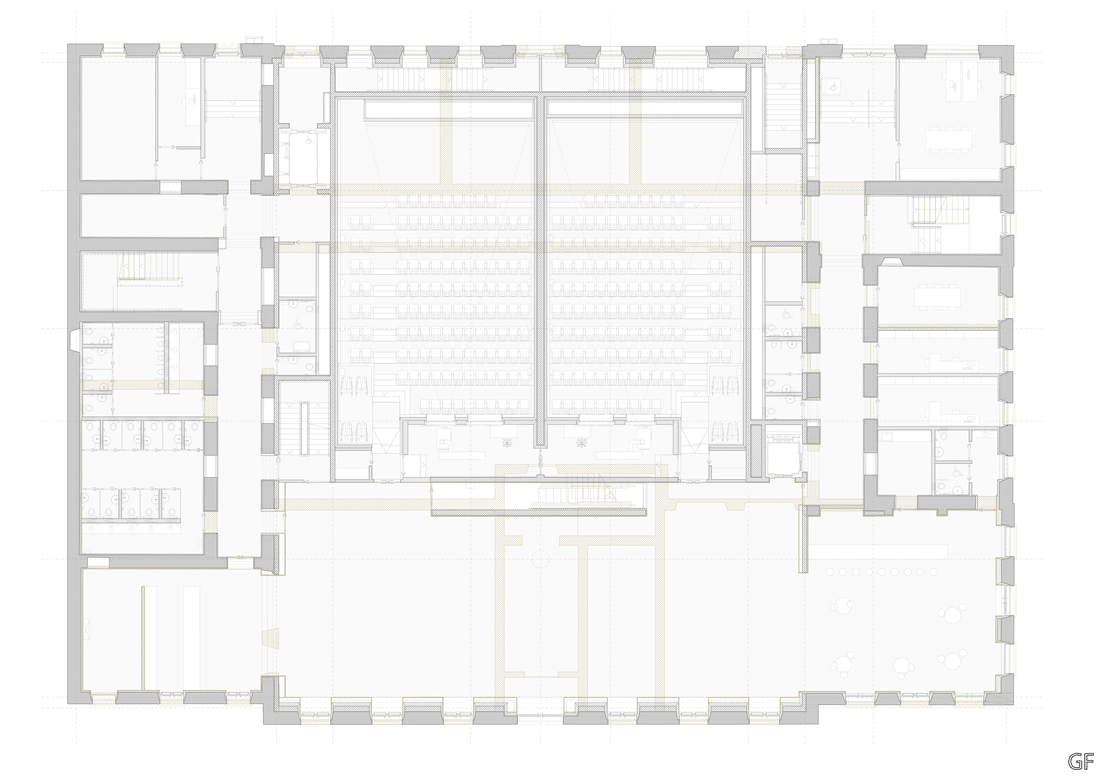 Floor Plans
Floor Plans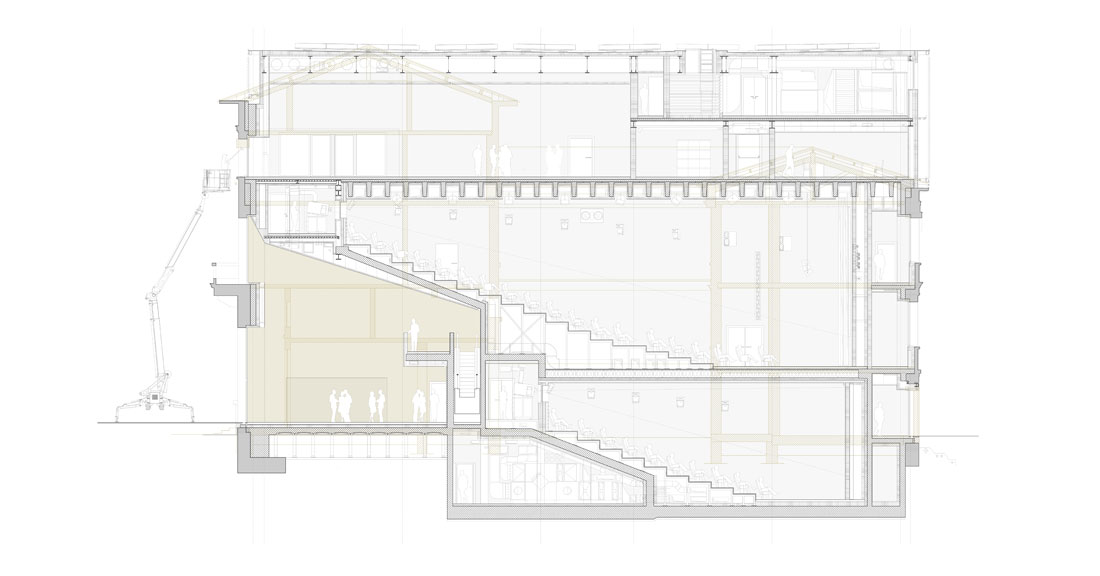 Cross Section
Cross Section
Optimising urban location
The project presents an important determination, which is to become a milestone for the city of Locarno, but also to establish a dialogue between the current and future urban layout of the city.
In this sense, the decision to keep a compact volume within the footprint of the existing building at the northern end of the site determines the consolidation of the current situation. Preserving the entirety of the Piazza Remo Rossi for public use, at the entrance to the old town, is a crucial strategy for the location of these important institutions within Locarno. The resulting volume will preside over Locarno’s skyline from some of its most relevant views, such as the traffic roundabout and the Piazza Castello.
Other than the preservation of its current size, the treatment we propose for Piazza Remo Rossi focuses on getting a new identity for this space, referring to the new institution to be located there: the Film Festival. We have used the image of the red carpet, associated with the Film Festival protocols, to rebrand this space of the city in relation to the Film Festival: Piazza Remo Rossi will become the Red Carpet Piazza, consolidating the presence of the Film Festival in Locarno’s structure of open spaces.
This semantic strategy will be physically incorporated by paving the square with red natural stone, like the kind that is widely used in Ticino to pave public spaces, so that the piazza will become a permanent red carpet. We will also relocate the two elms in the centre of the Piazza to allow for projections onto the façade of the building and to improve accessibility in the transition zone between via F. Rusca and the Red Carpet Piazza. All the trees in the Piazza will be preserved. We will therefore obtain a completely clear space, linked to the institution, able to host an array of activities such as red carpets, awards ceremonies, screenings, open-air events, etc.
Architecture, massing and superficial treatment
There are two types of strategies in the architectural proposal:
Functional. The most important problem to resolve is how to fit the film theatres – with capacities of 550 and 2×150 seats – within the existing building structure, preserving its integrity as much as possible. This has been achieved by stacking the large theatre on top of the small theatres, so that a foyer for the theaters is viable on the ground level. This is also a good structural solution, which places the bigger spans when there is less public access. It is worth noting the remarkable ability of the old building to be adapted to the new program, resulting in worthy and noble spaces for the new uses.
Our proposal for the new Palazzo del Cinema di Locarno aims to synthesise a new identity for the existing building in conjunction with its new use. In order to host the full program for the complex within the footprint of the Palazzo Scolastico, we had to raise a whole floor above the cornice of the old building, exhausting the building regulation’s maximum volume. This extension of the envelope has been treated as a simple and abstract volume which “overflows” the old container and displays textures that are associated with the Festival’s branding. Thus, the treatment of the top of the building refers to the colours and signs of identity of the Festival: gold for the Pardo d’Oro. An irregular perforation of the golden panels, using the diffusion pattern that occurs in leopard skin, will allow light to filter inside to light the workspace on the top levels of the building. It will also act as a themed night lantern presiding over Locarnos’s night sky.
The existing fabric will otherwise be painted white in order to optimise its performance as a projection surface, except the reveals of the windows which will be gold plated too, as though the new institution is parasiting the old shell and overflowing it.
Program
The approach to the program aims to allow the different sectors (SC, AF, CCCA) to function as a whole, or as separate entities, independently from each other. The different functional sectors have been located in different wings of the building, placing communication spaces and shared interaction spaces (cafeteria, multipurpose room, foyer) in the intersections between them.
SC. Cinema and Multipurpose Hall
This part of the program is mainly located in the emptied central area of the existing structure. In order to place the three rooms and the foyer in this space, the rooms have been stacked, placing the main hall on the first floor coinciding with the same level of pre-existing slabs.
The foyer is developed in height between the PB (at level +198) and P1, oriented towards Piazza Remo Rossi. This is a space with a large volume, with access to cinema rooms 2 and 3 at PB and through escalators to the main cinema room located on the upper level; part of the foyer is also located on this level.
The organizational approach of this sector is that it can function independently from the rest of the building so it could even be used as a commercial cinema with regular screenings, accessed from the lobby on Piazza Remo Rossi. Existing stairs will be retained as an exit and fire escape to Via Rusca.
AF. Festival Administration Sector
This sector is placed in the west wing of the building, with an access from Via Franchino Rusca. The floorplan uses its current layout with offices laid out along a corridor, which will be lit through transparent panels above the doors. Internal walled structure and stairs will be kept entirely and one floor will be added to accommodate the required program. The storage areas not requiring any windows have been placed on PB, the office areas are on existing floors 1 and 2, and the open space is located on level 3, linked to the multipurpose room and cafeteria area.
CCCA. Centre of Cinematographic and Audiovisual Development
This centre is located in the east wing of the building, adding one level and expanding towards the central area where the large multipurpose space will be located.
The sector for the CCCA is located primarily in existing spaces, except for the laboratory area, which can be located in the interior zone of P3. This sector comprises the Film Commission, Archive Casa del Cinema and Continuous Education.
The multipurpose space is located on the top floor with the possibility of being used from the three sectors (AF, CCCA, SC), directing its main access to the core SC sector so that it can be reached directly from the foyer and main cinema room, for events like congresses or conferences.
The cafeteria is proposed as an open space for the relationship between all the centres and is situated along the main façade overlooking the Red Carpet Square, directly opposite the main entrance to the multipurpose room.
Sustainability performance
Our proposal has carefully considered the environmental performance of the project, which revolves around 5 principles:
Compactness. An increase in the compactness of the building will contribute to the efficiency in the energy performance of the building.
Flexibility. The new intervention is designed with maximum flexibility in its program. The proposed layout is able to accommodate constant re-programming. The ability to adjust to new program requirements is a premise for sustainability and increases the possibility of the building being re-used in the future.
Materials. Reduction in the embodied energy of materials (ACV) – the emissions associated with the manufacture, transport and deconstruction – is an important concern of the project. By increasing the durability of the building, we provide an improvement in the ratio of emissions associated with construction for the entire life cycle. In order to achieve this, we have opted for the use of mineral materials for the fixed building components, promoting durable low-emissivity. The specification of durable, low-embodied energy materials for finishes, expected to remain unchanged throughout the life of the building will contribute to this strategy.
Energy. To reduce the emissions due to the use of the building, we have considered three levels of action: demand reduction, improved energy efficiency of systems, and improved building management. Electricity, heating and cooling production based on a tri-generation system will be considered, as well as building management systems to adjust the consumption to the specific needs. Most importantly, the retention of a structure with high thermal inertia is a benefit that will impact the energy consumption of the building.
Water. Rainwater harvesting systems are planned for the use of toilets, watering and cleaning, and energy-efficient bathroom fittings activated by photocells.
Health. The building also incorporates improvements to in terms of health and interior comfort. It has a network of natural electromagnetic radiation dissipation in the foundation slab, as well as flooring and conductive materials with low levels of volatile organic compounds (VOCs).

